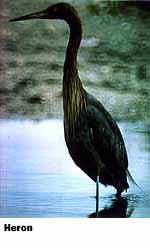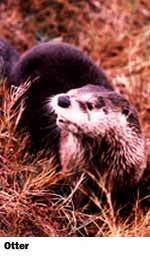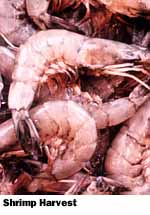|

 Only recently have we begun to understand the importance
of the functions that wetlands perform. Far from being useless, disease-
ridden places, wetlands provide values that no other ecosystem can,
including natural water quality improvement, flood protection, shoreline erosion
control, opportunities for recreation and
aesthetic appreciation, and natural products
for our use at no cost. Wetlands can provide one or more of these
functions. Protecting wetlands in turn can protect our safety and
welfare. Only recently have we begun to understand the importance
of the functions that wetlands perform. Far from being useless, disease-
ridden places, wetlands provide values that no other ecosystem can,
including natural water quality improvement, flood protection, shoreline erosion
control, opportunities for recreation and
aesthetic appreciation, and natural products
for our use at no cost. Wetlands can provide one or more of these
functions. Protecting wetlands in turn can protect our safety and
welfare.
Water Quality and Hydrology

 Wetlands have important
filtering capabilities for intercepting surface- water runoff from higher
dry land before the runoff reaches open water. As the runoff water passes
through, the wetlands retain excess nutrients and some pollutants, and
reduce sediment that would clog waterways and affect fish and amphibian
egg development. In performing this filtering function, wetlands save us
a great deal of money. For example, a 1990 study showed that, without
the Congaree Bottomland Hardwood Swamp in South Carolina, the area would
need a $5 million waste water treatment plant. Wetlands have important
filtering capabilities for intercepting surface- water runoff from higher
dry land before the runoff reaches open water. As the runoff water passes
through, the wetlands retain excess nutrients and some pollutants, and
reduce sediment that would clog waterways and affect fish and amphibian
egg development. In performing this filtering function, wetlands save us
a great deal of money. For example, a 1990 study showed that, without
the Congaree Bottomland Hardwood Swamp in South Carolina, the area would
need a $5 million waste water treatment plant.
 In addition to
improving water quality through filtering, some wetlands maintain stream
flow during dry periods, and many replenish groundwater. Many Americans
depend on groundwater for drinking. In addition to
improving water quality through filtering, some wetlands maintain stream
flow during dry periods, and many replenish groundwater. Many Americans
depend on groundwater for drinking.
Flood Protection

 Wetlands function as
natural sponges that trap and slowly release surface water, rain,
snowmelt, groundwater and flood waters. Trees, root mats, and other
wetland vegetation also slow the speed of flood waters and distribute
them more slowly over the floodplain. This combined water storage and
braking action lowers flood heights and reduces erosion. Wetlands within
and downstream of urban areas are particularly valuable, counteracting
the greatly increased rate and volume of surface- water runoff from
pavement and buildings. Wetlands function as
natural sponges that trap and slowly release surface water, rain,
snowmelt, groundwater and flood waters. Trees, root mats, and other
wetland vegetation also slow the speed of flood waters and distribute
them more slowly over the floodplain. This combined water storage and
braking action lowers flood heights and reduces erosion. Wetlands within
and downstream of urban areas are particularly valuable, counteracting
the greatly increased rate and volume of surface- water runoff from
pavement and buildings.
 The holding capacity of
wetlands helps control floods and prevents water logging of crops.
Preserving and restoring wetlands, together with other water retention,
can often provide the level of flood control otherwise provided by
expensive dredge operations and levees. The bottomland hardwood-
riparian wetlands along the Mississippi River once stored at least 60
days of floodwater. Now they store only 12 days because most have been
filled or drained. The holding capacity of
wetlands helps control floods and prevents water logging of crops.
Preserving and restoring wetlands, together with other water retention,
can often provide the level of flood control otherwise provided by
expensive dredge operations and levees. The bottomland hardwood-
riparian wetlands along the Mississippi River once stored at least 60
days of floodwater. Now they store only 12 days because most have been
filled or drained.
Shoreline Erosion
 The ability of wetlands
to control erosion is so valuable that some states are restoring wetlands
in coastal areas to buffer the storm surges from hurricanes and tropical
storms. Wetlands at the margins of lakes, rivers, bays, and the ocean
protect shorelines and stream banks against erosion. Wetland plants hold
the soil in place with their roots, absorb the energy of waves, and break
up the flow of stream or river currents. The ability of wetlands
to control erosion is so valuable that some states are restoring wetlands
in coastal areas to buffer the storm surges from hurricanes and tropical
storms. Wetlands at the margins of lakes, rivers, bays, and the ocean
protect shorelines and stream banks against erosion. Wetland plants hold
the soil in place with their roots, absorb the energy of waves, and break
up the flow of stream or river currents.
Fish and Wildlife Habitat

 More than one-third
of the United States' threatened and endangered species live only in
wetlands, and nearly half use wetlands at some point in their lives.
Many other animals and plants depend on wetlands for survival. More than one-third
of the United States' threatened and endangered species live only in
wetlands, and nearly half use wetlands at some point in their lives.
Many other animals and plants depend on wetlands for survival.
 Estuarine and marine
fish and shellfish, various birds, and certain mammals must have coastal
wetlands to survive. Most commercial and game fish breed and raise their
young in coastal marshes and estuaries. Menhaden, flounder, sea trout,
spot, croaker, and striped bass are among the more familiar fish that
depend on coastal wetlands. Shrimp, oysters, clams, and blue and
Dungeness crabs likewise need these wetlands for food, shelter, and
breeding grounds. Estuarine and marine
fish and shellfish, various birds, and certain mammals must have coastal
wetlands to survive. Most commercial and game fish breed and raise their
young in coastal marshes and estuaries. Menhaden, flounder, sea trout,
spot, croaker, and striped bass are among the more familiar fish that
depend on coastal wetlands. Shrimp, oysters, clams, and blue and
Dungeness crabs likewise need these wetlands for food, shelter, and
breeding grounds.

 For many animals and
plants, like wood ducks, muskrat, cattails, and swamp rose, inland
wetlands are the only places they can live. Beaver may actually create
their own wetlands. For others, such as striped bass, peregrine falcon,
otter, black bear, raccoon, and deer, wetlands provide important food,
water, or shelter. Many of the U.S. breeding bird populations-- including
ducks, geese, woodpeckers, hawks, wading birds, and many song-birds--
feed, nest, and raise their young in wetlands. Migratory waterfowl use
coastal and inland wetlands as resting, feeding, breeding, or nesting
grounds for at least part of the year. Indeed, an international agreement
to protect wetlands of international importance was developed because
some species of migratory birds are completely dependent on certain
wetlands and would become extinct if those wetlands were destroyed. For many animals and
plants, like wood ducks, muskrat, cattails, and swamp rose, inland
wetlands are the only places they can live. Beaver may actually create
their own wetlands. For others, such as striped bass, peregrine falcon,
otter, black bear, raccoon, and deer, wetlands provide important food,
water, or shelter. Many of the U.S. breeding bird populations-- including
ducks, geese, woodpeckers, hawks, wading birds, and many song-birds--
feed, nest, and raise their young in wetlands. Migratory waterfowl use
coastal and inland wetlands as resting, feeding, breeding, or nesting
grounds for at least part of the year. Indeed, an international agreement
to protect wetlands of international importance was developed because
some species of migratory birds are completely dependent on certain
wetlands and would become extinct if those wetlands were destroyed.
Natural Products for Our
Economy

 We use a wealth of
natural products from wetlands, including fish and shellfish,
blueberries, cranberries, timber, and wild rice, as well as medicines
that are derived from wetland soils and plants. Many of the nation's
fishing and shellfishing industries harvest wetland- dependent species;
the catch is valued at $15 billion a year. In the Southeast, for example,
nearly all the commercial catch and over half of the recreational harvest
are fish and shellfish that depend on the estuary- coastal wetland
system. Louisiana's coastal marshes produce an annual commercial fish
and shellfish harvest that amounted to 1.2 billion pounds worth $244
million in 1991. Wetlands are habitats for fur-bearers like muskrat,
beaver, and mink as well as reptiles such as alligators. The nation's
harvest of muskrat pelts alone is worth over $70 million annually. We use a wealth of
natural products from wetlands, including fish and shellfish,
blueberries, cranberries, timber, and wild rice, as well as medicines
that are derived from wetland soils and plants. Many of the nation's
fishing and shellfishing industries harvest wetland- dependent species;
the catch is valued at $15 billion a year. In the Southeast, for example,
nearly all the commercial catch and over half of the recreational harvest
are fish and shellfish that depend on the estuary- coastal wetland
system. Louisiana's coastal marshes produce an annual commercial fish
and shellfish harvest that amounted to 1.2 billion pounds worth $244
million in 1991. Wetlands are habitats for fur-bearers like muskrat,
beaver, and mink as well as reptiles such as alligators. The nation's
harvest of muskrat pelts alone is worth over $70 million annually.
Recreation and
Aesthetics

 Wetlands have
recreational, historical, scientific, and cultural values. More than half
of all U.S. adults (98 million) hunt, fish, birdwatch or photograph
wildlife. They spend a total of $59.5 billion annually. Painters and
writers continue to capture the beauty of wetlands on canvas and paper,
or through cameras, and video and sound recorders. Others appreciate
these wonderlands through hiking, boating, and other recreational
activities. Almost everyone likes being on or near the water; part of the
enjoyment is the varied, fascinating lifeforms. Wetlands have
recreational, historical, scientific, and cultural values. More than half
of all U.S. adults (98 million) hunt, fish, birdwatch or photograph
wildlife. They spend a total of $59.5 billion annually. Painters and
writers continue to capture the beauty of wetlands on canvas and paper,
or through cameras, and video and sound recorders. Others appreciate
these wonderlands through hiking, boating, and other recreational
activities. Almost everyone likes being on or near the water; part of the
enjoyment is the varied, fascinating lifeforms.
|
|

